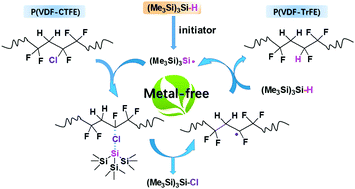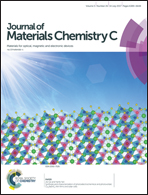Synthesis of poly(vinylidene fluoride–trifluoroethylene) via a controlled silyl radical reduction of poly(vinylidene fluoride–chlorotrifluoroethylene)
Abstract
Poly(vinylidene fluoride–trifluoroethylene) (P(VDF–TrFE)) has long been known for its excellent dielectric, ferroelectric and piezoelectric performances. Besides direct copolymerization of VDF and TrFE, hydrogenation of P(VDF–CTFE) has been extensively investigated to synthesize P(VDF–TrFE) for its advantages of low-cost raw materials and better controlled composition, together with mild reaction conditions. To overcome the negative influence of metal ions from the residue of catalysts on the dielectric performance of the resultant copolymers, in the present contribution, a hydrosilane catalyst system with no metal species has been reported for the hydrogenation of P(VDF–CTFE) in a controlled radical chain transfer reaction process. C–Cl bonds in CTFE are activated by silyl radicals which are in situ formed from the catalysts. The generated P(VDF–CTFE) micro-radicals would undergo a chain transfer reaction to Si–H on hydrosilane and generate new silyl radicals. The repeated chain transfer reactions between C–Cl bonds on CTFE and Si–H bonds on hydrosilane are responsible for the quantitative hydrogenation of P(VDF–CTFE) with respect to the hydrosilane dose. The low sensitivity of hydrosilane and the radical reaction pathway allow the reaction to be conducted under rather mild conditions in most of the good solvents of P(VDF–CTFE). Thanks to the metal-free feature of the catalyst, the resultant copolymer shows significantly improved dielectric performance over that catalyzed with copper complex catalysts. Reducing P(VDF–CTFE) with hydrosilane, such as (Me3Si)3SiH, has been demonstrated to be an environmentally friendly, controllable, metal-free and mild process to synthesize a TrFE containing fluoropolymer, which has glorious prospects for the synthesis of dielectric fluoropolymers.



 Please wait while we load your content...
Please wait while we load your content...